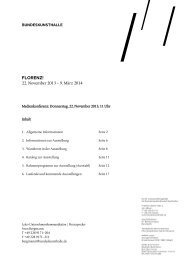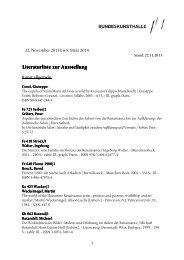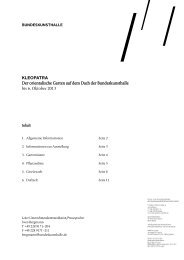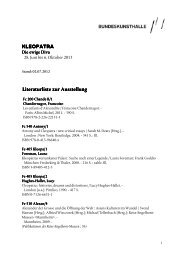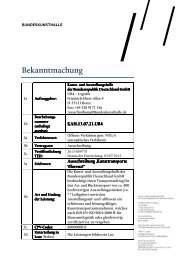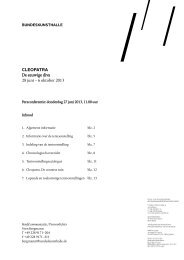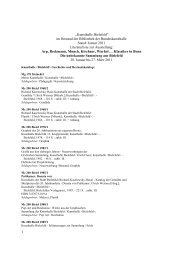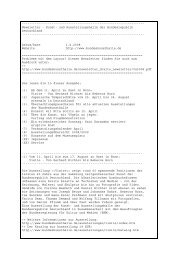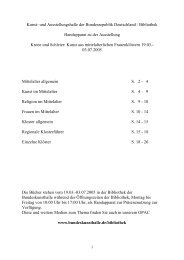Peoples through space and time Archaeology in Germany 09.05 ...
Peoples through space and time Archaeology in Germany 09.05 ...
Peoples through space and time Archaeology in Germany 09.05 ...
Create successful ePaper yourself
Turn your PDF publications into a flip-book with our unique Google optimized e-Paper software.
28 years. The broad spectrum of burial gifts - weapons, jewelry <strong>and</strong> food - po<strong>in</strong>t to differences <strong>in</strong> status,<br />
prestige or esteem of those who died, although it is not possible to determ<strong>in</strong>e a social structure from<br />
them.<br />
Beside such ‘regular’ burials, the Late Stone Age often presents strange habits <strong>in</strong> treat<strong>in</strong>g its dead.<br />
Skeleton parts found at a settlement site, smashed bones of at least 1,000 previously flayed bodies found<br />
<strong>in</strong> the graves of a late L<strong>in</strong>ienb<strong>and</strong>keramik settlement near Herxheim <strong>in</strong> the Palat<strong>in</strong>e <strong>and</strong> more show that<br />
Neolithic farm<strong>in</strong>g cultures observed a much wider variety of burial rituals than previously expected.<br />
08<br />
Technological Change <strong>and</strong> Innovation<br />
Dur<strong>in</strong>g the later Neolithic Age, arable l<strong>and</strong> areas were extended <strong>and</strong> l<strong>and</strong> was put to different use,<br />
allow<strong>in</strong>g production to <strong>in</strong>crease, thus also effect<strong>in</strong>g a rise <strong>in</strong> population. An <strong>in</strong>creased dem<strong>and</strong> for<br />
textiles from plant fibers <strong>and</strong> wool was met by exp<strong>and</strong><strong>in</strong>g the cultivation of flax <strong>and</strong> sheep.<br />
In the 4 th millennium B.C. an <strong>in</strong>novative leap occurred <strong>through</strong> the <strong>in</strong>vention of ox-driven plowshares,<br />
the wheel <strong>and</strong> wagon, which produced technological <strong>and</strong> economic change. Many cart paths <strong>in</strong> the<br />
moors of Northern <strong>and</strong> Southern <strong>Germany</strong> give testimony to the expansion of a traffic system.<br />
Another <strong>in</strong>novation with an equally wide impact is represented by the use of metal <strong>and</strong> the productive<br />
division of labor connected with it. Copper was first imported, <strong>and</strong> then extracted from quarries <strong>and</strong><br />
m<strong>in</strong>es.<br />
The Discovery of Metal<br />
The oldest metal objects were found <strong>in</strong> the Near East. Yet copper m<strong>in</strong><strong>in</strong>g took place <strong>in</strong> South Eastern<br />
Europe soon after, from where it began to be exported <strong>in</strong>to Central Europe as of the 5 th milennium B.C.<br />
Further production centers were established subsequently <strong>in</strong> the area of today’s Slovakia. Because of the<br />
impurities typical of the copper m<strong>in</strong>ed from this area, the orig<strong>in</strong> of the one of the oldest metal objects to<br />
have been found north of the Alps can be attributed to it: a copper disk found at the Hornstaad<br />
settlement on Lake Constance.<br />
From the turn of the 5 th to 4 th millennium B.C. copper technology began to play an important role next<br />
to that of traditional stonework <strong>in</strong> Central Europe. However, it was not until later <strong>in</strong> the 4 th millennium<br />
B.C. that copper first began to be quarried <strong>and</strong> then later m<strong>in</strong>ed on an <strong>in</strong>dependent basis.<br />
The Invention of Wheel <strong>and</strong> Wagon<br />
One of the most significant technical <strong>in</strong>novations for mank<strong>in</strong>d was the <strong>in</strong>vention of the wheel <strong>and</strong><br />
wagon. Up until recently it was considered to be an irrefutable fact that both orig<strong>in</strong>ated <strong>in</strong> the Near East.<br />
Yet this theory has come <strong>in</strong>to doubt <strong>through</strong> the discovery of wooden wheels <strong>in</strong> the marshl<strong>and</strong><br />
settlements <strong>in</strong> Switzerl<strong>and</strong> <strong>and</strong> <strong>in</strong> the Federsee Moor from the foothills of the Alps, dated at 3000 B.C. It<br />
is possible that the wheel <strong>and</strong> wagon were <strong>in</strong>vented <strong>in</strong> various places <strong>in</strong>dependently of each other.<br />
Recent excavations at the foothills of the Alps have provided valuable <strong>in</strong>sights <strong>in</strong>to the construction of<br />
New Stone Age wagons. Here the only type to have been found was a two-wheeled cart with a<br />
revolv<strong>in</strong>g axis <strong>and</strong> a width of circa 1.2 m, apparently used for transport<strong>in</strong>g agricultural goods. The<br />
chassis sat loosely on the axis <strong>and</strong> was removable. In contrast, four-wheeled wagons with immovable<br />
axes were found <strong>in</strong> Northern <strong>Germany</strong> <strong>and</strong> the central Danube area.<br />
Liv<strong>in</strong>g on the Water<br />
Research on settlements built on stilts is be<strong>in</strong>g carried out <strong>through</strong>out the Alp<strong>in</strong>e region <strong>and</strong> on the shore<br />
regions of the Baltic Sea. Intense research has proven that s<strong>in</strong>ce 4200 B.C., build<strong>in</strong>gs were erected not<br />
only on stilts but also directly on l<strong>and</strong> <strong>in</strong> shorel<strong>in</strong>e <strong>and</strong> moor settlements. As a result, a long research<br />
controversy was resolved.<br />
An excellent example for research on a stilt settlement <strong>in</strong> which archaeological <strong>and</strong> scientific methods<br />
were applied is the Hornstaad Settlement on Lake Constance from 3900 B.C., excavated s<strong>in</strong>ce 1983.<br />
More important than the build<strong>in</strong>g f<strong>in</strong>ds are the diverse general <strong>in</strong>sights ga<strong>in</strong>ed on the environmental,<br />
economic <strong>and</strong> cultural history of the late Neolithic Age. The whitewashed walls of cult build<strong>in</strong>gs found<br />
<strong>in</strong> the stilt settlements <strong>in</strong> Ludwighafen <strong>and</strong> Sippl<strong>in</strong>gen on Lake Constance, dated at 3850 B.C., are<br />
decorated with reliefs, symbols <strong>and</strong> naturalist ceramic depictions of female breasts.<br />
10




